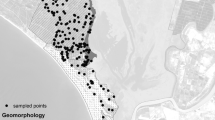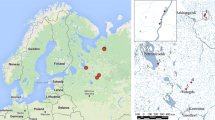Abstract
A vegetation survey was carried out in a relatively intact Atlantic blanket bog in Southwest Ireland to study the vegetation patterns in relation to environmental variation, and to quantify the effect of artificial and natural borders on compositional variation. The data were analysed using canonical correspondence analysis. In terms of both vegetation and water chemistry, the study site can be categorized as typical of Atlantic blanket bogs in the maritime regions of North-western Europe. The distribution of plant species was explained mainly by depth of the water table. The distribution of bryophytes was secondarily explained by the pH of the bog water, while the distribution of vascular plants was secondarily explained by concentrations of ammonia. The vegetation distribution exhibited little variation between the central sector of the peatland and its disturbed edges (hill-grazing and restoration areas), but a substantial variation was observed between the area along a natural edge (stream) and the areas close to the other peatland borders or centre. Similarly, the internal variation within each sector (centre, hill-grazing edge and restoration area edge) was small, but substantial vegetation variation was observed within the area located along the stream. The area along the stream was associated with relatively deep water table, shallow peat depth, high water colour, pH and NH4 + concentrations, and low Cl− concentrations in the bog water. Our results suggest the existence of strong centre-natural margin gradients, as in raised bogs, and indicate that human or animal disturbance do not give rise to the marked transition zones that often characterize natural margins of mire systems. This indicates that even small areas and remnants of Atlantic blanket bogs are worthy of conservation and that their conservation value would benefit from the inclusion of sectors close to the natural peatland borders, which would increase the plant biodiversity of the conserved area.






Similar content being viewed by others
References
Adamson JK, Scott WA, Rowland AP et al (2001) Ionic concentration in a blanket peat bog in northern England and correlations with deposition and climate variables. Eur J Soil Sci 52:69–79. doi:10.1046/j.1365-2389.2001.t01-1-00350.x
Belyea LR (1999) A novel indicator of reducing conditions and water-table depth in mires. Funct Ecol 13:431–434. doi:10.1046/j.1365-2435.1999.00333.x
Belyea LR, Clymo RS (1998) Do hollows control the rate of peat bog growth? In: Standen V, Tallis JH, Meade R (eds) Patterned mires and mire pools. Origin and development flora and fauna. British Ecological Society, London, pp 55–65
Boatman DJ (1961) Vegetation and peat characteristics of blanket bogs in county Kerry. J Ecol 49:507–517. doi:10.2307/2257220
Boatman DJ (1983) The Silver Flow national nature reserve, Galloway, Scotland. J Biogeogr 10:163–274. doi:10.2307/2844692
Boatman DJ, Armstrong W (1968) A bog type in North-West Sutherland. J Ecol 56:129–141. doi:10.2307/2258072
Booth RK, Hotchkiss SC, Wilcox DA (2005) Discoloration of polyvinyl chloride (PVC) tape as a proxy for water-table depth in peatlands: validation and assessment of seasonal variability. Funct Ecol 19:1040–1047. doi:10.1111/j.1365-2435.2005.01048.x
Bragazza L, Gerdol R (2002) Are nutrient availability and acidity–alkalinity gradients related in Sphagnum-dominated peatlands? J Veg Sci 13(4):473–482. doi:10.1658/1100-9233(2002)013[0473:ANAAAA]2.0.CO;2
Bubier JL (1995) The relationship of vegetation to methane emission and hydrochemical gradients in northern peatlands. J Ecol 83:403–420. doi:10.2307/2261594
Bubier JL, Moore TR, Bellisario L et al (1995) Ecological controls on methane emissions from a northern peatland complex in the zone of discontinuous permafrost, Manitoba, Canada. Global Biogeochem Cycles 9:455–470. doi:10.1029/95GB02379
Douglas C (1998) Blanket bog conservation. In: O’Leary G, Gormley F (eds) Towards a conservation strategy for the bogs of Ireland. Irish Peatland Conservation Council, Dublin, pp 205–222
Douglas C, Garvey L, Kelly L et al (1989) A survey to locate blanket bogs of scientific interest in county Kerry and county Sligo. Wildlife Service, Office of Public Works, Dublin
Doyle GJ (1982) The vegetation, ecology and productivity of Atlantic blanket bog in Mayo and Galway, western Ireland. In: White J (ed) Studies on Irish vegetation. Royal Dublin Society, Dublin, pp 147–164
Doyle GJ (1990) Phytosociology of Atlantic blanket bog complexes in north-west Mayo. In: Doyle G (ed) Ecology and conservation of Irish peatlands. Royal Irish Academy, Dublin, pp 159–166
Foss PJ, O’Connell CA, Crushell PH (2001) Bogs & fens of Ireland. Conservation Plan 2005, Irish Peatland Conservation Council, Dublin
Glaser PH, Janssens JA, Siegel DI (1990) The response of vegetation to chemical and hydrological gradients in the Lost River peatland, Northern Minnesota. J Ecol 78:1021–1048. doi:10.2307/2260950
Hájková P, Hájek M (2004) Bryophyte and vascular plant responses to base-richness and water level gradients in western Carpathian Sphagnum-rich mires. Folia Geobot 39:335–351. doi:10.1007/BF02803207
Hájková P, Hájek M, Apostolova I (2006) Diversity of wetland vegetation in the Bulgarian high mountains, main gradients and context-dependence of the pH role. Plant Ecol 184:111–130. doi:10.1007/s11258-005-9056-5
Hammond RF (1981) The peatlands of Ireland, 2nd edn. An Foras Talúntais, Dublin
Hill MO, Bell N, Bruggemann-Nannenga MA et al (2006) An annotated checklist of the mosses of Europe and Macaronesia. J Bryol 28:198–267. doi:10.1179/174328206X119998
Laine A, Sottocornola M, Kiely G et al (2006) Estimating net ecosystem exchange in a patterned ecosystem: example from blanket bog. Agric Meteorol 138:231–243. doi:10.1016/j.agrformet.2006.05.005
Laine A, Wilson D, Kiely G et al (2007a) Methane flux dynamics in an Irish lowland blanket bog. Plant Soil 299:181–193. doi:10.1007/s11104-007-9374-6
Laine A, Byrne KA, Kiely G et al (2007b) Patterns in vegetation and CO2 dynamics along a water level gradient in a lowland blanket bog. Ecosystems (N Y, Print) 10:890–905. doi:10.1007/s10021-007-9067-2
Lepš J, Šmilauer P (2003) Multivariate analysis of ecological data using CANOCO. Cambridge University Press, Cambridge
Lindsay RA (1995) Bogs: the ecology, classification and conservation of ombrotrophic mires. Scottish Natural Heritage, Edinburgh
Lindsay RA, Charman DJ, Everingham F et al (1988) The flow country: the peatlands of Caithness and Sutherland. Nature Conservation Council, Peterborough
Malmer N (1986) Vegetational gradients in relation to environmental conditions in northwestern European mires. Can J Bot 64:375–383. doi:10.1139/b86-054
Miller RL, Bradford WL, Peters NE (1988) Specific conductance: theoretical considerations and application to analytical quality control. US Geol Surv Water Supply Pap 2311:1–16
Økland RH, Økland T, Rydgren K (2001) A Scandinavian perspective on ecological gradients in north-west European mires: reply to Wheeler and Proctor. J Ecol 89:481–486. doi:10.1046/j.1365-2745.2001.00573.x
Proctor MCF (1992) Regional and local variation in the chemical composition of ombrogenous mire waters in Britain and Ireland. J Ecol 80:719–736. doi:10.2307/2260862
Proctor MCF (2006) Temporal variation in the surface-water chemistry of a blanket bog on Dartmoor, southwest England: analysis of 5 years’data. Eur J Soil Sci 57:167–178. doi:10.1111/j.1365-2389.2005.00724.x
Sheehy Skeffington MJ, O’Connell CA (1998) Peatlands of Ireland. In: Giller PS (ed) Studies in Irish limnology. Marine Institute, Dublin, pp 39–66
Shotyk W (1997) Atmospheric deposition and mass balance of major and trace elements in two oceanic peat bog profiles, northern Scotland and the Shetland Islands. Chem Geol 138:55–72. doi:10.1016/S0009-2541(96)00172-6
Smith AJE (1990) The liverworts of Britain and Ireland. Cambridge University Press, Cambridge
Sottocornola M, Kiely G (2005) An Atlantic blanket bog is a modest CO2 sink. Geophys Res Lett 32(L23804). doi:10.1029/2005GL024731
Sparling JH (1967a) The occurrence of Schoenus nigricans L. in blanket bogs: I. Environmental conditions affecting the growth of S. nigricans in blanket bog. J Ecol 55:1–13. doi:10.2307/2257713
Sparling JH (1967b) The occurrence of Schoenus nigricans L. in blanket bogs: II. Experiments on the growth of S. nigricans under controlled conditions. J Ecol 55:15–31. doi:10.2307/2257714
Stace C (1997) New flora of the British Isles, 2nd edn. Cambridge University Press, Cambridge
Tahvanainen T, Tuomala T (2003) The reliability of mire water pH measurements—a standard sampling protocol and implications to ecological theory. Wetlands 23:701–708. doi:10.1672/0277-5212(2003)023[0701:TROMWP]2.0.CO;2
Tahvanainen T, Sallantaus T, Heikkilä R et al (2002) Spatial variation of mire surface water chemistry and vegetation in northeastern Finland. Ann Bot Fenn 39:235–251
Tallis JH (1998) Growth and degradation of British and Irish blanket mires. Environ Rev 6:81–122. doi:10.1139/er-6-2-81
Tansley AG (1965) The British islands and their vegetation, 4th Impression. Cambridge University Press, Cambridge
Ter Braak CJF, Šmilauer P (2002) CANOCO reference manual and CanoDraw for windows user’s guide: software for canonical community ordination (version 4.5). Microcomputer Power, Ithaca, New York
Tomlinson RW (2005) Soil carbon stocks and changes in the Republic of Ireland. J Environ Manage 76:77–93. doi:10.1016/j.jenvman.2005.02.001
Vitt DH, Chee W-L (1990) The relationships of vegetation to surface water chemistry and peat chemistry in fens of Alberta, Canada. Vegetatio 89:87–106. doi:10.1007/BF00032163
Vitt DH, Bayley SE, Tai-Long J (1995) Seasonal variation in water chemistry over bog-rich fen gradient in Continental Western Canada. Can J Fish Aquat Sci 52:587–606. doi:10.1139/f95-059
Wheeler BD, Proctor CF (2000) Ecological gradients, subdivisions and terminology of north-west European mires. J Ecol 88:187–203. doi:10.1046/j.1365-2745.2000.00455.x
Wind-Mulder HL, Rochefort L, Vitt DH (1996) Water and peat chemistry comparisons of natural and post-harvested peatlands across Canada and their relevance to peatland restoration. Ecol Eng 7:161–181. doi:10.1016/0925-8574(96)00004-3
Acknowledgements
This study was funded by the ERTDI Programme 2000–2006, financed by the Irish Government under the National Development Plan and administered on behalf of the Department of Environment and Local Government by the Environmental Protection Agency (CELTICFLUX 2001-CC-C2-M1). MS and AL were funded by Environmental Protection Agency PhD fellowships (Grant codes 2002_PhD2_47 and 2002_PhD2_46, respectively). Financial support from Academy of Finland (Project code 202424) to E-ST is appreciated. We thank Caitriona Douglas of NPWS and Coillte Teoranta for permission to use the study site, Peter Jones and Mairead Kiely of the Plant Science Department in UCC for the use of lab facilities for plants identification, the Aquatic Services Unit of University College Cork for analysing the water samples, and Julien Gillet for help in fieldwork. Useful discussions with Caitriona Douglas, Mary O’Connor, Petr Šmilauer and Teemu Tahvanainen are appreciated. We thank two anonymous reviewers for their useful comments and suggestions.
Author information
Authors and Affiliations
Corresponding author
Rights and permissions
About this article
Cite this article
Sottocornola, M., Laine, A., Kiely, G. et al. Vegetation and environmental variation in an Atlantic blanket bog in South-western Ireland. Plant Ecol 203, 69–81 (2009). https://doi.org/10.1007/s11258-008-9510-2
Received:
Accepted:
Published:
Issue Date:
DOI: https://doi.org/10.1007/s11258-008-9510-2




